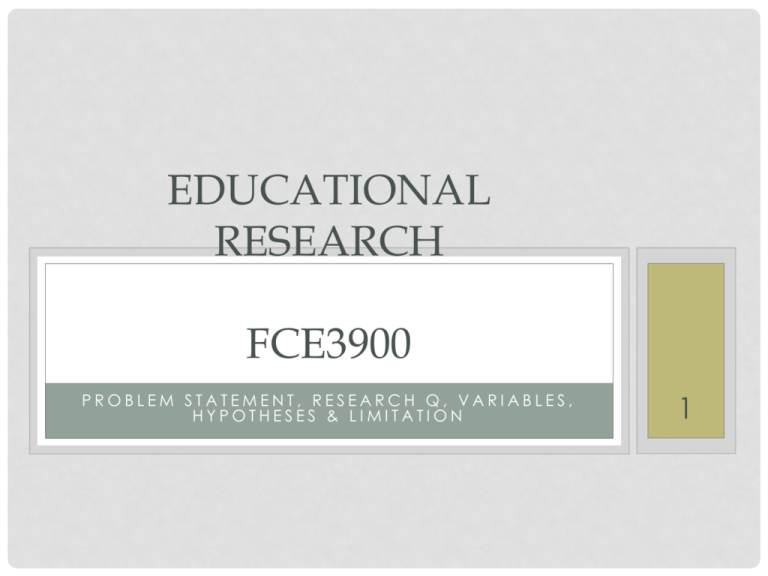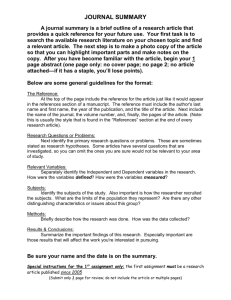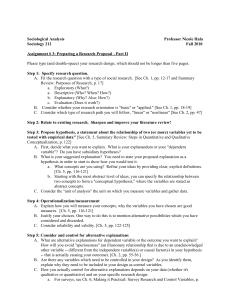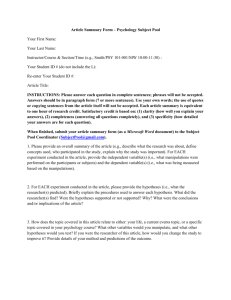A Research Question - UPM EduTrain Interactive Learning
advertisement

EDUCATIONAL RESEARCH FCE3900 PROBLEM STATEMENT, RESEARCH Q, VARIABLES, HYPOTHESES & LIMITATION 1 BODY OF WRITING RESEARCH REPORT Introduction Literature review Methodology Presentation and Analysis of the data Summary, conclusion and recommendations 2 INTRODUCTION Background of the study Research problem Research objective Research question / Hypothesis Research framework Operational Definition 3 WHAT IS THE LITERATURE REVIEW Main topic in research Theory related to the topic Models used to expand the research Previous studies 4 METHODOLOGY • • • • • • • • • Research design Location and selection of research subjects Population and Sampling Sampling technique Research Instruments Validity and reliability of the instrument Pilot Study Data Collection and Analysis Summary 5 Type of Sampling Non-probability Probability Simple Random Cluster Random Stratified Random Convenience Systematic Random Quota Judgement / Purposive Snowball 6 TYPES OF QUANTITATIVE METHODOLOGY • • • • • • Surveys Longitudinal Cross-sectional, correlation Experimental Quasi-experimental Ex-post facto research 7 OBJECTIVE • Discuss how problem areas can be identified. • State research problems clearly and precisely. • Explain how primary and secondary data help the researcher to develop a problem statement. • Define and study a problem and explain its importance to research • Distinguish between the research problem, topic, purpose and research questions • Identify criteria to decide whether to review or study problems • Distinguish qualitative and quantitative problems • Explain the five elements found in the statement of the problem "statement of the problem” • Identify strategies necessary to write the research problem statement • Three sources usually contribute to problem identification. • Own experience or the experience of others may be a source of problem supply. • A second source could be scientific literature. You may read about certain findings and notice that a certain field was not covered. This could lead to a research problem. • Theories could be a third source. Shortcomings in theories could be researched. • Research can thus be aimed at clarifying or substantiating an existing theory, at clarifying contradictory findings, at correcting a faulty methodology, at correcting the inadequate or unsuitable use of statistical techniques, at reconciling conflicting opinions, or at solving existing practical problems. DEFINITION RESEARCH PROBLEM • The first step in the research process is to choose a problem to investigate. The researcher begins with a general topic and then narrows it to a specific problem statement, which is a detailed description of the problem and its importance. PURPOSE OF PROBLEM STATEMENT • Introduces reader to importance of problem • Places problem in an educational context • Provides framework for reporting results—findings and conclusions IDENTIFICATION OF THE PROBLEM • The prospective researcher should think on what caused the need to do the research (problem identification). • Research originates from a need that arises. A clear distinction between the PROBLEM and the PURPOSE should be made. • The problem is the aspect the researcher worries about, think about, wants to find a solution for. The purpose is to solve the problem, ie find answers to the question(s). If there is no clear problem formulation, the purpose and methods are meaningless. CONT. IDENTIFICATION OF THE PROBLEM • Keep the following in mind: • Outline the general context of the problem area. • Highlight key theories, concepts and ideas current in this area. • What appear to be some of the underlying assumptions of this area? • Why are these issues identified important? • What needs to be solved? • Read round the area (subject) to get to know the background and to identify unanswered questions or controversies, and/or to identify the most significant issues for further exploration. CHARACTERISTIC PROBLEM STATEMENT • A problem statement describes the research problem and identifies potential causes or solutions. • A problem statement also conveys the reason the problem is important and who is affected by the problem • The problem must be significant enough to contribute to the existing body of research • The problem must be one that will lead to more research • It must be possible to investigate the problem through the collection of data • The problem must be interesting to the researcher and suit his skills, time and resources • The problem is ethical and will not harm others. FUNCTIONS OF A PROBLEM STATEMENT • Establishing - to establish the existence of two or more juxtaposed factors which, by their interaction produce an enigmatic or perplexing state, yield an undesirable consequence, or result in a conflict which renders the choice from among alternatives moot. • Relating - to relate the problem to its antecedents (i.e., educational, scientific, social). • Justifying - to justify the utility, significance, or interest inherent in the pursuit of the problem. TYPES OF PROBLEM STATEMENT • There are two general types of problem statements: • quantitative • qualitative. • The problem statement in a quantitative research study names the variables and population to be studied, and asks a question about the relationship between the variables. • A qualitative study, on the other hand, also begins with a problem statement, but it is stated much more broadly than in a quantitative study. IMPORTANCE OF RESEARCH PROBLEMS • Formulates a clear, concise, and manageable research problem • Communicates to others • Focus and importance of problem • Educational context and scope • Framework for reporting results • Indicates evidence-based inquiry THE THREE KEY CRITERIA FOR PROBLEM STATEMENT • There are three key criteria to assess the quality of the problem statement: • It should be relevant • It should be feasible • It should be interesting SOURCES OF PROBLEMS Casual observation Relationship between cognition and affect Relative effectiveness of positive or negative reinforcement Deductions from theory Effectiveness of using math manipulatives Relationship between instructional style and learning style Related literature Study of dropouts in your locale Use of math manipulatives in secondary schools SOURCES OF PROBLEMS • Current social and political issues • Gender and race equity • Inclusion • Practical situations • Evaluations of specific programs • Effectiveness of local initiatives • Personal experience and insight • Teaching statistical courses from an applied perspective • Effectiveness of non-threatening classroom assessments PURPOSE STATEMENT AND PROBLEM STATEMENT • Purpose statement describes the purpose of the study. • Eg: The purpose of this study is to investigate the relationship between the use of Internet communication between teachers and parents in the district and school achievement tests for students in civics and citizenship subjects. • Problem statement focuses on the problem that will be studied. • E.g. Does the frequency of communication between teachers and parents on the internet affect students’ achievement in tests in civics and citizenship subjects? QUANTITATIVE VS QUALITATIVE RESEARCH QUESTIONS • QUALI Example: How do newly appointed school principals learn about their school culture and norms? • QUALI Example: What forms of support does the new school principal seek in his/her administration in school? • QUANTI: Does specific types of school culture facilitate better organizational socialization for newly appointed principals? • QUANTI: The relationship of systemic familiarity on the learning experience of newly appointed school principals. RESEARCH VARIABLE VARIABLE • Is a concept that contain variations of quality, intensity, and degree. • Composed of attributes that express a construct • Each variable a separate and distinct phenomenon • Two types based on what is measured • Categorical variables— groups are qualitatively different example teaching method • Continuous measured variable (quantitative variable) which measures degree, amount or quantity such as age, height. RESEARCH VARIABLE TYPES • In experimental research • Independent—comes first—influences or predicts • Also called manipulated or experimental variable • Antecedent • Dependent—comes second—if affected or predicted by independent variable • Consequence INDEPENDENT AND DEPENDENT VARIABLES • Independent variables are those that the researcher chooses to study to assess their possible effect(s) on one or more variables. • Dependent variable is presumed to be affected by the independent variable. • An Independent variable may be manipulated for example in experimental studies. These variables are called experimental variables or treatment variables. RESEARCH VARIABLE TYPES • In non-experimental research • Independent variable cannot be manipulated • In correlational studies • Antecedent called predictor variable • Dependent variable called criterion • Not always possible to tell which comes first • When prediction not goal, but rather to see if there is a relationship between MODERATOR VARIABLES • Moderator variable is a special type of independent variable. It is a secondary independent variable that has been selected in order to determine if it affects or modifies the basic relationship between the primary independent variable and the dependent variable. • RQ: Does anxiety affect test performance, and if so, does it depend on test taking experience? MEDIATOR VARIABLES • While a moderator variable can modify or influence the strength of a relationship between two other variables, a mediator variable attempts to explain the relationship between the two other variables. • RQ: do high school students taught by the inquiry method perform better on tests of critical thinking than high school students taught by demonstration method, and if so, does it vary with grade level? • Moderator: grade level • Mediator: economic status might explain the relationship between method and performance on critical thinking test. EXTRANEOUS VARIABLE • These are independent variables that have not been controlled. Example: personality of teacher, time of the day the classes are taught, the type of learning activities that day etc • One way to control extraneous variable is to hole them constant, OBJECTIVES OF RESEARCH WHAT IS OBJECTIVE RESEARCH • The objectives of a research project summarize what is to be achieved by the study. These objectives should be closely related to the research problem. • The general objective of a study states what researchers expect to achieve by the study in general terms. It is possible (and advisable) to break down a general objective into smaller, logically connected parts. These are normally referred to as specific objectives. • Specific objectives should systematically address the various research questions. They should specify what you will do in your study, where and for what purpose. TYPES OF OBJECTIVE • The general objective: to imagine the purpose of solving problems presented in the statement of the problem. Example: "the relationship between student achievement goals of teaching methods adopted for accounting subjects”. • The specific objectives of: Example: “Determine the relationship between teacher practices with the goal of constructivist approach to the achievement of students in accounting classes”. OBJECTIVE VERBS labeling measure compile explain proposing Explain link analyze discuss lists Revising know synthesize paint mention copy gather watching recording Prepare defines believe projected formulate find predict defend Sensitizing copy identify weld build work state prove understand compare notify distinguish assess Renovate manipulating RESEARCH QUESTIONS • A Research Question is a statement that identifies the phenomenon to be studied. For example, “What resources are helpful to new and minority drug abuse researchers?” TYPES OF RESEARCH QUESTIONS • • • • • • • • Existence Description and Classification Composition Relationship Descriptive-Comparative Causality Causality-Comparative Causality-Comparative Interaction WHAT IS A GOOD RESEARCH QUESTION? • Relevant. • Manageable in terms of research and in terms of your own academic abilities. • Substantial and with original dimensions. • Consistent with the requirements of the assessment. • Clear and simple. • Interesting. RELEVANT • The question will be of academic and intellectual interest to people in the field you have chosen to study. The question arises from issues raised in the literature or in practice. • You should be able to establish a clear purpose for your research in relation to the chosen field. For example, are you filling a gap in knowledge, analysing academic assumptions or professional practice, monitoring a development in practice, comparing different approaches or testing theories within a specific population? MANAGEABLE • You need to be realistic about the scope and scale of the project. The question you ask must be within your ability to tackle. • Sometimes a research question appears feasible, but when you start your fieldwork or library study, it proves otherwise. In this situation, it is important to write up the problems honestly and to reflect on what has been learnt. It may be possible, with your supervisor, to develop a contingency plan to anticipate possible problems of access. SUBSTANTIAL AND (WITHIN REASON) ORIGINAL • The question should not simply copy questions asked in other final year modules, or modules previously undertaken. It shows your own imagination and your ability to construct and develop research issues. And it needs to give sufficient scope to develop into a dissertation. CLEAR AND SIMPLE • The complexity of a question can frequently hide unclear thoughts and lead to a confused research process.. • Equally, you will want to get started with your literature review and data collection, and you may feel tempted to 'make do' with a broad and vague research question for the moment. However, a muddled question is likely to generate muddled data and equally muddled analysis. • If you create a clear and simple research question, you may find that it becomes more complex as you think about the situation you are studying and undertake the literature review. Having one key question with several sub-components will guide your research here. INTERESTING • This is key! The question needs to be one that interests you and is likely to remain intriguing for the duration of the project. There are two traps to be avoided. • First, some questions are convenient - the best you can come up with when you are asked to state a question on a form, maybe – or perhaps the question fits in with your units so you decide it will suffice. • Second, some questions are fads. They arise out of a particular set of personal circumstances, for example a job application. Once the circumstances change you can lose enthusiasm for the topic and it becomes very tedious. • Make sure that you have a real, grounded interest in your research question, and that you can explore this and back it up by academic and intellectual debate. It is your interest that will motivate you to keep working and to produce a good dissertation. HYPOTHESIS DEFINITION OF HYPOTHESIS • A research hypothesis is the statement created by researchers when they speculate upon the outcome of a research or experiment. By Martyn Shuttleworth (2008) • It is an informed/educated guess. • It indicates the expectations of the researcher regarding certain variables. • It is the most specific way in which an answer to a problem can be stated. • Mouton's (1990: Chapter 6) and Guy's (1987: 116) presentation of the hypothesis: THE PURPOSE AND FUNCTION OF AN HYPOTHESIS • It offers explanations for the relationships between those variables that can be empirically tested. • It furnishes proof that the researcher has sufficient background knowledge to enable him/her to make suggestions in order to extend existing knowledge. • It gives direction to an investigation. • It structures the next phase in the investigation and therefore furnishes continuity to the examination of the problem. EXAMPLE OF HYPOTHESIS • Will students who are taught history by a teacher of the same gender like the subject more than students taught by a teacher of a different gender? • HYPOTHESIS: Students taught history by a teacher of the same gender will like the subject more than students taught history by a teacher of a different gender. TYPES OF HYPOTHESES • NULL HYPOTHESES • ALTERNATIVE HYPOTHESES: Directional versus nondriectional NULL HYPOTHESES • Designated by: H0 or HN • The null hypothesis represents a theory that has been put forward, either because it is believed to be true or because it is to be used as a basis for argument, but has not been proved. • Has serious outcome if incorrect decision is made ALTERNATIVE HYPOTHESES • Designated by: H1 or HA • Only reached if H0 is rejected. • Frequently “alternative” is actual desired conclusion of the researcher DIRECTIONAL HYPOTHESES • Indicates the specific direction that the researcher expects to emerge in a relationship. • Ha: Female students will perform higher in mathematics test compared to boys NON DIRECTIONAL HYPOTHESES • Not specific in the direction of change in the dependent variable • Ha: Mathematics performance between girls and boys will be different Ha: There will be a difference between the scores on an attitude measure of students with academic disabilities in special classes and such students placed in regular classes QUALITATIVE RESEARCH HYPOTHESIS • Typically, hypotheses are not stated at the beginning of a qualitative study. • New hypotheses are generated as a result of what the researcher finds as they observe patterns and relationships in natural setting. • BUT, researchers of qualitative study DO state some propositions intended to GUIDE researchers in their collection and analysis of qualitative data. Propositions are not intended to be tested against the data as is done in quantitative research. EDUCATIONAL RESEARCH CHAPTER 2 LITERATURE REVIEW 56





